
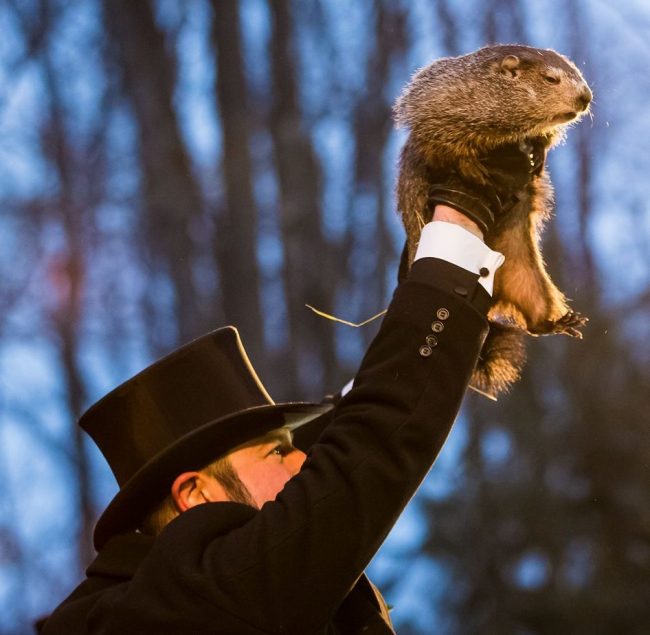
North America’s most famous groundhog – Pennsylvania’s Punxsutawney Phil – held up by a member of the Inner Circle of the Punxsutawney Groundhog Club on February 2, 2018. Image via Wikimedia Commons.
Every February 2, legend has it that a groundhog emerges from his burrow and looks around. Either it’s sunny and he sees his shadow, which, in folklore, means six more weeks of winter. Or it’s cloudy, and the groundhog doesn’t see his shadow, meaning an early spring. Since 1887, a certain groundhog (and his successors) in Punxsutawney, Pennsylvania – Punxsutawney Phil – has been North America’s most famous weather predictor. But the seasonal traditions of this holiday go back a long way, long before Phil. Though you might not have realized it, Groundhog Day is an astronomical holiday – a cross-quarter day – falling approximately midway between the December solstice and the March equinox.
In this pandemic year, 2021, there will be no in-person events on Groundhog Day in Punxsutawney, Pennsylvania. That’s according to the video below from the Punxsutawney Groundhog Club’s Inner Circle, released in November 2020. The club is asking visitors to stay home rather than travel to Phil’s annual celebration. If you’d like to watch Phil’s weather prediction this year, you can do so online.
How to watch Groundhog Day 2021:
– www.groundhog.org
– Punxsutawney Phil’s Facebook
– Punxsutawney Phil’s Youtube
– PCN
– Satellite coordinates
EarthSky 2021 lunar calendars now available! Order now. Going fast!
Join us at 6:30 a.m. for a 'Groundhog Special' followed by Phil's live prognostication on Feb. 2nd!
How to Watch…Posted by Punxsutawney Phil on Thursday, January 28, 2021
Groundhog Day as a cross-quarter day. Every cross-quarter day is actually a collection of dates, all falling approximately midway between the solstices and the equinoxes. Many cultures celebrate traditions and holidays at this time. February 2 is the year’s first cross-quarter day. There are three other cross-quarter days, including, in North America, the celebration of Halloween.
The division of the year into segments is a common theme in human cultures. Our ancestors were more aware of the sun’s movements across the sky than we are, since their plantings and harvests depended on it.
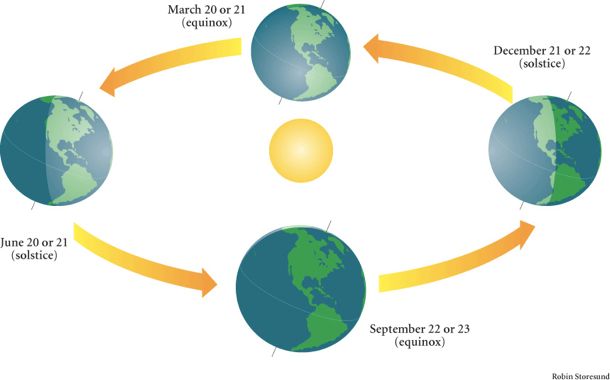
The equinoxes, solstices and cross-quarter days are events that take place in Earth’s orbit around the sun.
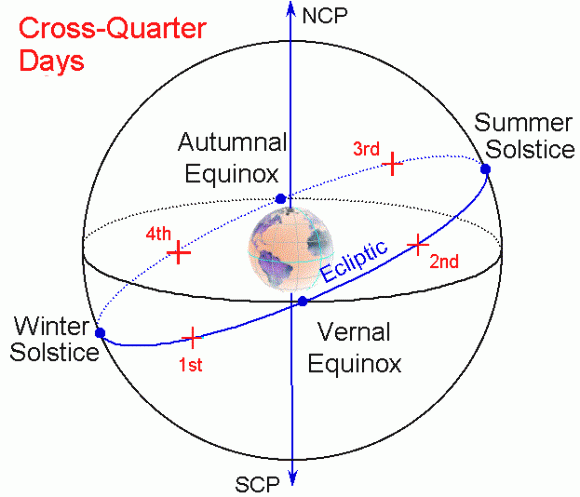
The cross-quarter days fall midway between the solstices and equinoxes. Groundhog Day is the 1st cross-quarter day of the year. Illustration via NASA.
Punxsutawney Phil, the great weather prognosticator. By far the most famous of the February 2 shadow-seeking groundhogs is Punxsutawney Phil in Punxsutawney, in western Pennsylvania, which calls itself:
… original home of the great weather prognosticator, His Majesty, the Punxsutawney Groundhog.
In most years (but not 2021), members of the Punxsutawney Groundhog Club hold public celebrations of Groundhog Day. The February 2 celebration was captured in the Bill Murray movie “Groundhog Day” over and over and over again.
How accurate is Phil? NOAA’s National Climatic Data Center says Phil’s forecasts have shown no predictive skill in recent years. Phil gets it right about 35-40% of the time.
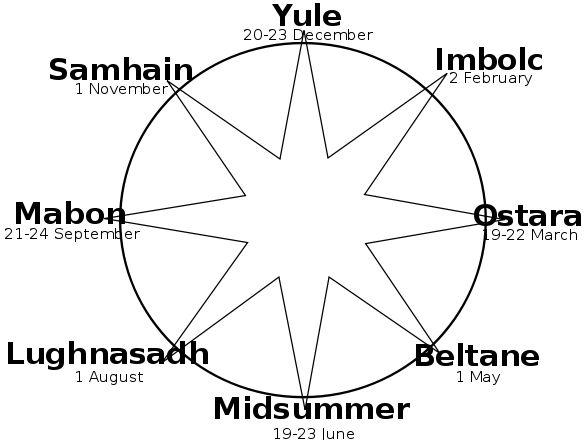
Neo-pagan wheel of the year. Image via Wikimedia Commons.
Groundhog Day in history and culture. In the Celtic calendar, the year is also divided into quarter days (equinoxes and solstices) and cross-quarter days on a great neo-pagan wheel of the year. Thus, just as February 2 is marked by the celebration of Candlemas by some Christians, such as the Roman Catholics, in contemporary paganism this day is called Imbolc and is considered a traditional time for initiations.
The celebration of Groundhog Day came to America along with immigrants from Great Britain and Germany. The tradition can be traced to early Christians in Europe, when a hedgehog was said to look for his shadow on Candlemas Day.
Try this old English rhyme:
If Candlemas Day be fair and bright, winter will have another flight. But if it be dark with clouds and rain, winter is gone and will not come again.
Or here’s another old saying:
Half your wood and half your hay, you should have on Candlemas Day.
In Germany, where a badger was said to watch for his shadow, the saying goes:
A shepherd would rather see a wolf enter his stable on Candlemas Day than see the sun shine.
A friend on Facebook said that, in Portugal, people have a poem about February 2 related to the Lady of Candles. Here’s the poem:
Quando a Senhora das Candeias está a rir está o inverno para vir, quando está a chorar está o inverno a acabar. [Translation: If Our Lady of Candles smiles (Sun) the winter is yet to come, if she cries (Rain) the winter is over.]
One final note. It’s supposed to be bad luck to leave your Christmas decorations up after Groundhog Day.
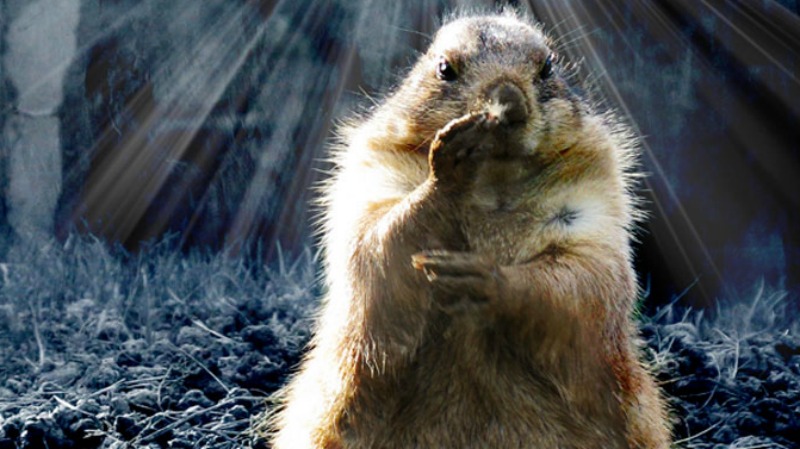
A groundhog. Image via kidskonnect.
Bottom line: Groundhog Day happens on February 2 every year and coincides with astronomy’s first cross-quarter day of each year, marking the midpoint between the winter solstice and spring equinox. The strange manner of weather prognostication has deep roots in history.
Enjoying EarthSky so far? Sign up for our free daily newsletter today!
from EarthSky https://ift.tt/2vFlbkv


North America’s most famous groundhog – Pennsylvania’s Punxsutawney Phil – held up by a member of the Inner Circle of the Punxsutawney Groundhog Club on February 2, 2018. Image via Wikimedia Commons.
Every February 2, legend has it that a groundhog emerges from his burrow and looks around. Either it’s sunny and he sees his shadow, which, in folklore, means six more weeks of winter. Or it’s cloudy, and the groundhog doesn’t see his shadow, meaning an early spring. Since 1887, a certain groundhog (and his successors) in Punxsutawney, Pennsylvania – Punxsutawney Phil – has been North America’s most famous weather predictor. But the seasonal traditions of this holiday go back a long way, long before Phil. Though you might not have realized it, Groundhog Day is an astronomical holiday – a cross-quarter day – falling approximately midway between the December solstice and the March equinox.
In this pandemic year, 2021, there will be no in-person events on Groundhog Day in Punxsutawney, Pennsylvania. That’s according to the video below from the Punxsutawney Groundhog Club’s Inner Circle, released in November 2020. The club is asking visitors to stay home rather than travel to Phil’s annual celebration. If you’d like to watch Phil’s weather prediction this year, you can do so online.
How to watch Groundhog Day 2021:
– www.groundhog.org
– Punxsutawney Phil’s Facebook
– Punxsutawney Phil’s Youtube
– PCN
– Satellite coordinates
EarthSky 2021 lunar calendars now available! Order now. Going fast!
Join us at 6:30 a.m. for a 'Groundhog Special' followed by Phil's live prognostication on Feb. 2nd!
How to Watch…Posted by Punxsutawney Phil on Thursday, January 28, 2021
Groundhog Day as a cross-quarter day. Every cross-quarter day is actually a collection of dates, all falling approximately midway between the solstices and the equinoxes. Many cultures celebrate traditions and holidays at this time. February 2 is the year’s first cross-quarter day. There are three other cross-quarter days, including, in North America, the celebration of Halloween.
The division of the year into segments is a common theme in human cultures. Our ancestors were more aware of the sun’s movements across the sky than we are, since their plantings and harvests depended on it.

The equinoxes, solstices and cross-quarter days are events that take place in Earth’s orbit around the sun.

The cross-quarter days fall midway between the solstices and equinoxes. Groundhog Day is the 1st cross-quarter day of the year. Illustration via NASA.
Punxsutawney Phil, the great weather prognosticator. By far the most famous of the February 2 shadow-seeking groundhogs is Punxsutawney Phil in Punxsutawney, in western Pennsylvania, which calls itself:
… original home of the great weather prognosticator, His Majesty, the Punxsutawney Groundhog.
In most years (but not 2021), members of the Punxsutawney Groundhog Club hold public celebrations of Groundhog Day. The February 2 celebration was captured in the Bill Murray movie “Groundhog Day” over and over and over again.
How accurate is Phil? NOAA’s National Climatic Data Center says Phil’s forecasts have shown no predictive skill in recent years. Phil gets it right about 35-40% of the time.

Neo-pagan wheel of the year. Image via Wikimedia Commons.
Groundhog Day in history and culture. In the Celtic calendar, the year is also divided into quarter days (equinoxes and solstices) and cross-quarter days on a great neo-pagan wheel of the year. Thus, just as February 2 is marked by the celebration of Candlemas by some Christians, such as the Roman Catholics, in contemporary paganism this day is called Imbolc and is considered a traditional time for initiations.
The celebration of Groundhog Day came to America along with immigrants from Great Britain and Germany. The tradition can be traced to early Christians in Europe, when a hedgehog was said to look for his shadow on Candlemas Day.
Try this old English rhyme:
If Candlemas Day be fair and bright, winter will have another flight. But if it be dark with clouds and rain, winter is gone and will not come again.
Or here’s another old saying:
Half your wood and half your hay, you should have on Candlemas Day.
In Germany, where a badger was said to watch for his shadow, the saying goes:
A shepherd would rather see a wolf enter his stable on Candlemas Day than see the sun shine.
A friend on Facebook said that, in Portugal, people have a poem about February 2 related to the Lady of Candles. Here’s the poem:
Quando a Senhora das Candeias está a rir está o inverno para vir, quando está a chorar está o inverno a acabar. [Translation: If Our Lady of Candles smiles (Sun) the winter is yet to come, if she cries (Rain) the winter is over.]
One final note. It’s supposed to be bad luck to leave your Christmas decorations up after Groundhog Day.

A groundhog. Image via kidskonnect.
Bottom line: Groundhog Day happens on February 2 every year and coincides with astronomy’s first cross-quarter day of each year, marking the midpoint between the winter solstice and spring equinox. The strange manner of weather prognostication has deep roots in history.
Enjoying EarthSky so far? Sign up for our free daily newsletter today!
from EarthSky https://ift.tt/2vFlbkv

Aucun commentaire:
Enregistrer un commentaire